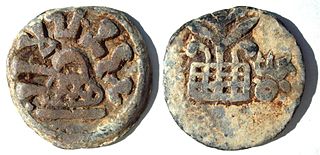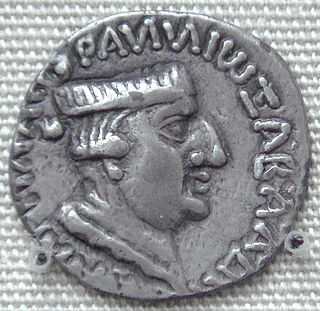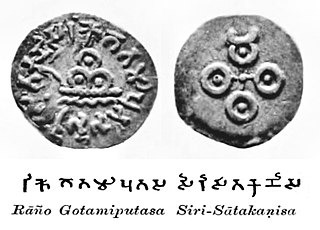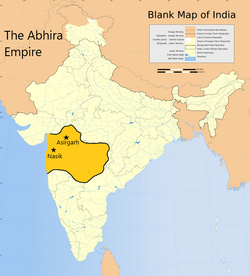
Chandragupta II, also known by his title Vikramaditya, as well as Chandragupta Vikramaditya, was the third ruler of the Gupta Empire in India. Modern scholars generally identify him with King Chandra of the Delhi iron pillar inscription.

The Satavahanas, also referred to as the Andhras in the Puranas, were an ancient Indian Brahmin dynasty based in the Deccan region. Most modern scholars believe that the Satavahana rule began in the late second century BCE and lasted until the early third century CE, although some assign the beginning of their rule to as early as the 3rd century BCE based on the Puranas, but uncorroborated by archaeological evidence. The Satavahana kingdom mainly comprised the present-day Andhra Pradesh, Telangana, and Maharashtra. At different times, their rule extended to parts of modern Gujarat, Madhya Pradesh, and Karnataka. The dynasty had different capital cities at different times, including Kotalingala(Telangana), Pratishthana (Paithan) and Amaravati (Dharanikota).

The Chutu dynasty ruled parts of the Deccan region of South India between first and third centuries CE, with its capital at Banavasi in present-day Karnataka state. The Chutus probably rose to power as Satavahanas feudatories, and assumed sovereignty after the decline of the Satavahana power. Except for the edicts of Asoka, the inscriptions of the Chutu dynasty are the oldest documents found in the northern part of Karnataka State, India.
The Western Satraps, or Western Kshatrapas were Indo-Scythian (Saka) rulers of the western and central parts of India, between 35 and 415 CE. The Western Satraps were contemporaneous with the Kushans who ruled the northern part of the Indian subcontinent, and were possibly vassals of the Kushans. They were also contemporaneous with the Satavahana (Andhra) who ruled in Central India. They are called "Western Satraps" in modern historiography in order to differentiate them from the "Northern Satraps", who ruled in Punjab and Mathura until the 2nd century CE.

Nahapana, was an important ruler of the Western Kshatrapas, descendant of the Indo-Scythians, in northwestern India, who ruled during the 1st or 2nd century CE. According to one of his coins, he was the son of Bhumaka.

Gautamiputra Satakarni was a ruler of the Satavahana Empire in present-day Deccan region of India. He was mentioned as the important and greatest ruler of Satavahana Dynasty. He ruled in the 1st or 2nd century CE, although his exact period is uncertain. His reign is dated variously: 86-110 CE, c. 103-127 CE, 106-130 CE, or more recently and specifically ca. 60-85 CE.
Pauni is a town and a Municipal Council in Bhandara district in the Indian state of Maharashtra. Now it has National Highway NH-247. Pauni is also known as Kashi of Vidarbha due to its wide swath of temples.

The Traikutakas were a dynasty of Indian kings who ruled between 388 and 456. The name "Traikutakas" seems to be derived from the words for a three-peaked mountain ("Tri-kuta"). The Traikutakas are mentioned in Kalidasa's Raghuvamsa, in which they are located in the area of northern Konkan. The dominions of the Traikutakas further included Aparanta and northern Maharashtra.

Rudrasimha III was the last ruler of the Western Satraps in India, in the 4th century AD. Rudrasimha III succeeded Rudrasena IV as the leader of the Indo-Scythians in India. Both were the sons of the Saka ruler Satyasimha, making them at least half-brothers, if not first-degree relatives.
Nashik is a historically, mythologically, socially and culturally important city in the northern part of the state of Maharashtra in India. It is known for the temples on the banks of the Godavari and it has historically been one of the holy sites of the Hindu religion. It is one of the four cities that hosts the massive Sinhastha Kumbh Mela once every twelve years.

Jivadaman was a Saka ruler of the Western Kshatrapas in northwestern India from during the 2nd century CE. He was the son of Damajadasri I (170–175), and the brother of Satyadaman.

Rudrasimha I was a Western Kshatrapa ruler, who reigned from 178 to 197 CE. He was son of Rudradaman I, grandson of Jayadaman, and grand-grandson of Chashtana. During his reign, the Abhiras became increasingly important. Some of them were even serving as generals. Ashvini Agrawal thinks that the Abhira king Isvardatta was a general in the service of Rudrasimha I who deposed his master in 188 A.D and ascended the throne. Ashvini Agrawal further says that Rudrasimha I soon deposed him and regained the throne in 190 A.D.

Ishwarsena was the founder of the Abhira dynasty and he started an era which later became known as the Kalchuri-Chedi era. He and his descendants whose names do not occur in the Puranas seem to have ruled over a large territory comprising Gujarat, Konkan and Western Maharashtra. His descendants ruled for nine generations.
The Abhiras were a legendary people mentioned in ancient Indian epics and scriptures as early as the Vedas. they were a warlike tribe is admitted by all. Probably they were a nomadic people as they are associated with various peoples and provinces. A historical people of the same name are mentioned in the Periplus of the Erythraean Sea. The Mahabharata describes them as living near the seashore and on the bank of the Sarasvati River, near Somnath in Gujarat.

The Kalachuri dynasty, also known as Kalachuris of Malwa or Mahismati, or the Early Kalachuris, was the ruling dynasty of the Kingdom of Malwa between 6th and 7th centuries. The territory ruled by them included parts of present-day Gujarat, Madhya Pradesh, and Maharashtra. Their capital was located at Mahishmati. Epigraphic and numismatic evidence suggests that the earliest of the Ellora and Elephanta cave monuments were built during the Kalachuri rule.

Rudrasena II (256–278) was a king of the Western Satraps, and the 19th ruler of the Kshatrapa dynasty. The Kshatrapa dynasty seems to have reached a high level of prosperity under his rule.

Yasodhaman II (317–332) was a son and probably sub-king of king Rudrasimha II of the Western Satraps. He declared on his coins to be the son of Rudrasimha II.

Sridharavarman was a Saka (Indo-Scythian) ruler of Central India, around the areas of Vidisa, Sanchi and Eran in the 4th century CE, just before the Gupta Empire expansion in these areas. He calls himself a general and "righteous conqueror" in an inscription, and Rajan ('King') and Mahaksatrapa in a probably later inscription at Eran, suggesting that he may have been a high-ranked officer who later rose to the rank of a King.

The Gupta-Saka Wars refers to the military conflict between the Gupta Empire, ruled by Chandragupta II, and the Western shatrapas, also known as the Shakas, during the 4th century CE.


















